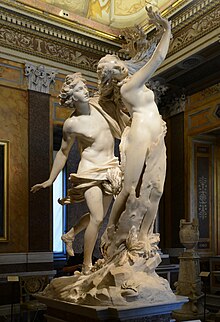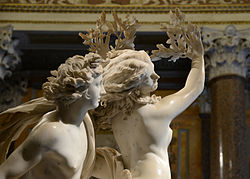Apollo and Daphne (Bernini)
| Apollo and Daphne | |
|---|---|
 | |
| Artist | Gian Lorenzo Bernini |
| Year | 1622–25 |
| Catalogue | 18 |
| Type | Sculpture |
| Medium | Marble |
| Dimensions | 243 cm (96 in) |
| Location | Galleria Borghese, Rome |
| 41°54′50.4″N 12°29′31.2″E / 41.914000°N 12.492000°E | |
Apollo and Daphne is a life-sized Baroque marble sculpture by Italian artist Gian Lorenzo Bernini, executed between 1622 and 1625. Housed in the Galleria Borghese in Rome, the work depicts the climax of the story of Daphne and Phoebus in Ovid's Metamorphoses.
History

The sculpture was the last of a number of artworks commissioned by Cardinal Scipione Borghese, early on in Bernini's career. Apollo and Daphne was commissioned after Borghese had given an earlier work of his patronage, Bernini's Pluto and Persephone, to Cardinal Ludovico Ludovisi.[1]
Much of the early work was done in 1622–1623, but a pause, quite possibly to work on the sculpture of David, interrupted its completion, and Bernini did not finish the work until 1625. Indeed, the sculpture itself was not moved to the Cardinal's Villa Borghese until September 1625.[2] Bernini did not execute the sculpture by himself; he had significant help from a member of his workshop, Giuliano Finelli, who undertook the sculpture of the details that show Daphne's conversion from human to tree, such as the bark and branches, as well as her windswept hair.[3] Some historians, however, discount the importance of Finelli's contribution.[4]
While the sculpture may be appreciated from multiple angles, Bernini planned for it to be viewed side on, allowing the observer to see the reactions of Apollo and Daphne simultaneously, thus understanding the narrative of the story in a single instant, without the need to move position.[5]
Iconography
When Phoebus (Apollo), fated by Cupid's love-exciting arrow, sees the maiden daughter of Peneus a river god, he is filled with wonder at her beauty and consumed by desire. But Daphne has been fated by Cupid's love-repelling arrow and denies the love of men. As the Nymph flees he relentlessly chases her—boasting, pleading, and promising everything. When her strength is finally spent she prays to her father Peneus:
'Destroy the beauty that has injured me, or change the body that destroys my life.' Before her prayer was ended, torpor seized on all her body, and a thin bark closed around her gentle bosom, and her hair became as moving leaves; her arms were changed to waving branches, and her active feet as clinging roots were fastened to the ground—her face was hidden with encircling leaves.[6]
Phoebus loved the graceful tree, clung to it and kissed the wood:
But since thou canst not be my spouse surely thou shalt be my tree. Thee O laurel my hair, thee my lyres, thee my quivers shall always have ... And as my head is youthful with unshorn locks, do thou likewise wear always evergreen honours of foliage. The laurel nodded assent with its branches lately made[7]
Critical reception
Despite Bernini's reputation falling after his death, Apollo and Daphne continued to be praised. A French traveller in 1839 commented that the group is "astonishing both for mechanism of art and elaborateness, is full of charm in the ensemble and the details."[8] One 19th century literary journal considered it the only Bernini work worthy of lasting praise.[9] Others were less positive. An English travel writer in 1829 noted Bernini's technical skill but added that the sculpture "bears all the want of judgment, taste, and knowledge of that age", going on to criticise the appearance of Apollo for being too like a shepherd and not enough like a god.[10]
More recent historians have been much more positive. Robert Torsten Petersson calls it "an extraordinary masterpiece ... suffused with an energy that works out of the tips of the laurel leaves and Apollo's hand and drapery." [11]
In popular culture
A photograph of the work is used on the cover of Lady Gaga's 2013 album Artpop
References
- Notes
- ^ Hibbard 1990, p. 38.
- ^ Wittkower 1955, p. 240.
- ^ Mormando 2011, p. 45.
- ^ Fenton 2000, p. 94.
- ^ Hibbard 1990, p. 40.
- ^ Ovid (More) Metamorphoses, Book I
- ^ Ovid (Giles) Metamorphoses, Book I.
- ^ Valery 1839, p. 596.
- ^ Campbell 1830, p. 99.
- ^ New Monthly Magazine 1829, p. 276.
- ^ Petersson 2002, p. 80.
- Bibliography
- Avery, Charles (1997). Bernini: Genius of the Baroque. London: Thames and Hudson. ISBN 9780500286333.
- Baldinucci, Filippo (2006) [1682]. The Life of Bernini. University Park: Pennsylvania State University Press. ISBN 9780271730769.
- Bernini, Domenico (2011) [1713]. The Life of Giano Lorenzo Bernini. University Park: Pennsylvania State University Press. ISBN 9780271037486.
- Campbell, T. (January 1830). "Remarks on Mr. Flaxman's Lectures on Sculpture". New Monthly Magazine and Literary Journal. 28 (109): 97–104.
- Dempsey, Charles (2000). Inventing the Renaissance Putto. Chapel Hill: University of North Carolina. ISBN 9780807826164.
- Fenton, James (2000). Leonardo's Nephew: Essays on Art and Artists. University of Chicago Press. ISBN 978-0-226-24147-0.
- Hibbard, Howard (1990). Bernini. London: Penguin. ISBN 978-0-14-193542-3.
- Mormando, Franco (2011). Bernini: His Life and His Rome. Chicago: University of Chicago Press. ISBN 978-0-22-653852-5.
- Ovid. Metmorphoses, Books I-IV. Translated by John Allen Giles. London: Cornish & Sons.
- Ovid (1922). Metmorphoses, Book I, vi. Translated by Brookes More. Boston: Cornhill Publishing Co.
- Petersson, Robert Torsten (2002). Bernini and the Excesses of Art. Fordham Univ Press. ISBN 978-88-87700-83-1.
- Valery, Antoine Claude Pasquin (1839). Historical, Literary, and Artistic Travels in Italy: A Complete and Methodical Guide for Travellers and Artists. Baudry. p. 596.
- "Walks in Rome and its Environs No. XVII". The New Monthly Magazine and Literary Journal. 25 (99): 275–282. March 1829.
- Wittkower, Rudolf (1955). Gian Lorenzo Bernini: The Sculptor of the Roman Baroque. London: Phaidon Press. ISBN 9780714837154.
- Welborn, Braden (2005-12-01). "Bernini's Apollo and Daphne From Behind". Prairie Schooner. 79 (4): 58. doi:10.1353/psg.2006.0049. ISSN 0032-6682.
Further reading
| External videos | |
|---|---|
- Barolsky, Paul. "Ovid, Bernini, and the Art of Petrification". Arion 13, no. 2 (1 October 2005): 149–162. JSTOR 29737267.
- Bolland, Andrea. "Desiderio and Diletto: Vision, Touch, and the Poetics of Bernini's Apollo and Daphne". The Art Bulletin 82, no. 2 (1 June 2000): 309–330. doi:10.2307/3051379.
- Kenseth, Joy. "Bernini's Borghese Sculptures: Another View". The Art Bulletin 63, no. 2 (1 June 1981): 191–210. doi:10.2307/3050112.
- Pinton, Daniele (2009). Bernini. Sculptor and Architect. ATS Italia Editrice. ISBN 9788875717773.
- Wilkins, Ann Thomas. "Bernini and Ovid: Expanding the Concept of Metamorphosis". International Journal of the Classical Tradition 6, no. 3 (1 December 2000): 383–408. doi:10.1007/s12138-000-0003-5.
